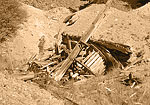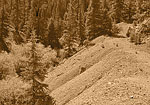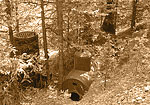

Oro Fino
Denmark
Deldosso
Silver Queen
Enderman



![]()
The Oro Fino Claims, also known as the Big Five, are located on the western side of Bitter Creek Canyon about one-half mile south of the Edison Mine (and thus, one-half mile south of the old town of Anchor). For practical purposes these claims should also include the Granger placer, two hundred feet south of the main operation, but shown on some maps as a separate mine.
The Oro Fino properties are almost unique among the Red River mines because of the fact that they were most heavily worked during the 1930s, at a time when most of the area mines had long since ceased to exist. By 1930, the gold rush days seemed over, most of the mines were idle, the town population was down to about 100 people, and Red River was becoming a tourist destination. However, in 1932, W. C. Wright, a miner from Alaska, came to the area. He selected a partner, C. C. Lowe, and purchased the Big Five interests, at that time a placer mining area.
Together, the two men began placer mining the claims. However, Lowe received a tip from Eric Alexander, the previous superintendent of the big Five, about a caved-in shaft which might be worth exploring. Lowe promptly cleaned and opened the tunnel and in the mine discovered a vein of rich gold. He filed on this as the Oro Fino claim and began major mining operations. It seems that Granger was not particularly interested in tunnel mining (lode mining), so he decided to continue his placer work. Granger refused a share in the Oro Fino and so Lowe gave up his rights to the placer. Thus the two partners continued to work a couple of hundred feet apart, but one operating a tunnel mine and the other engaging in placer mining.
C. L. Salisbury soon offered to lease the Oro Fino from Lowe for $150,000 and the offer was accepted. Thus the mine was taken over by the Salisbury and Van Horn company and new developments were put in place. With Salisbury as manager, four miners were hired to extend the tunnel and a mill was erected near the mine. All of this interest was rewarded by the discovery of a new vein assaying at up to $800 per ton enabling the now lessee to obtain a significant profit over the next several years. Meanwhile, Granger continued to work his placer mine, taking out a great deal of fine gold plus a number of nuggets.
During the mid-1930s Granger, for health reasons, was unable to work the claim so he asked Lowe to search for a possible lessee. A deal was worked with Salisbury and Van Horn to take over the placer operation as well as to continue to run the Oro Fino. This arrangement was profitable for all parties and it continued for several years. Around 1940 there developed major disagreements between the stockholders of the Salisbury Company so Crowe canceled the leases. However, Lowe himself was in poor health and unable to work the mine so in 1941 he leased the Oro Fino to another party. In that year the United States entered World Wax II and that event marked the end of most mining work in the Red River area.
Today there are a few remnants of both the Oro Fino and the Granger placer. The mine entrance (adit) is located above the stream, extends into the hillside and shows signs of timbers and some track. There are traces of a small mill near the adit with remains of a water wheel and a few pieces of machinery. The cabin is still standing, south of the mine and east of Bitter Creek. At the Granger placer are located a steam hoist and a steam engine with a large boiler and tall stack.

Oro Fino Area

Big Five Cabin

Big Five Wheel

Big Five Tailings

Granger Steam Hoist

Granger Steam Boiler

